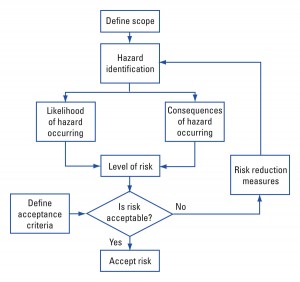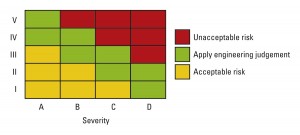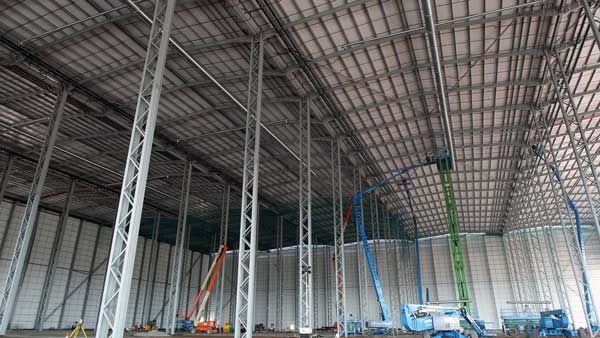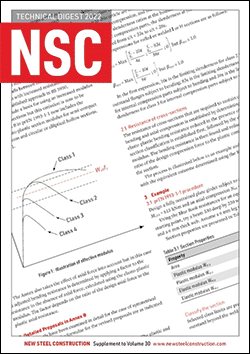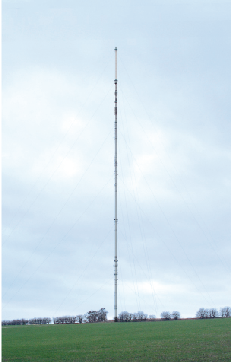Technical
Systematic Risk Assessments for Class 3 Buildings
Approved Document A of the Building Regulations requires that a systematic risk assessment is carried out for Class 3 buildings. But what does this mean for the practicing engineer? SCI’s Andrew Way explains.
Introduction
In June 2004 the Building Regulations of England and Wales[1] were amended. Requirement A3 (Disproportionate Collapse) now applies to all buildings regardless of the number of storeys. Approved Document A (2004 Edition)[2] defines four classes of building; Class 1, 2A, 2B and 3, and recommends that to comply with Requirement A3, a systematic risk assessment is required for Class 3 buildings. There is currently no specific guidance on how to carry out the required risk assessment. This article presents the SCI’s interim guidance on risk assessments for Class 3 buildings. SCI publication P341[3] provides design guidance for buildings of Class 1 to 2B. The SCI recommends that Class 3 buildings should have at least the same structural provisions for robustness as required for Class 2B buildings. This is expected to be the recommendation in the forthcoming amendment to BS 5950-1.
It must be kept in mind that the Building Regulations only require that buildings are designed to avoid disproportionate collapse not designed to resist all possible hazards.
The subject of risk is complex with numerous techniques and approaches for analysing, assessing and reducing risk. The discussion in this article provides simple guidance that can be applied to ‘ordinary’ Class 3 buildings. There will be buildings and other structures where advanced risk assessment procedures (such as those used in the off-shore and nuclear industries) are appropriate but these are outside the scope of this guidance.
As explained in this article and identified in Reference 4, the application of engineering judgement will play a major role in the risk assessment procedure due to the lack of guidance and the levels of uncertainty regarding likelihood and consequence of hazards.
The main steps of a risk assessment are shown in Figure 1. Risk is a function of the likelihood of a hazard occurring and the magnitude of the consequences of that hazard. This article provides guidance for each stage of the risk assessment.
Defining the scope
The scope of the risk assessment should include the purpose of the risk assessment (e.g. to demonstrate compliance with regulations), the time frame to be considered (e.g. the life of the building) and the types of hazards to be included (e.g. accidental actions). The building regulations are intended to guard against accidental events and therefore on this basis it would seem reasonable to exclude deliberate or malicious events from the scope of the risk assessment. If the building is required to be designed to resist malicious events such as terrorist attack this should be addressed separately. Designing buildings to avoid disproportionate collapse due to accidental hazards can provide some robustness to deliberate hazards.
Hazard Identification
Approved Document A states that the risk assessment should include; normal hazards that may reasonably be foreseen and any abnormal hazards. Hazards in general terms are events that have unwanted consequences, which for buildings is structural damage (and the consequential harm to people). The distinction between normal and abnormal hazards is unclear but the important point is that all reasonably foreseeable (accidental) hazards are included.
Below is a list of hazards that should be considered in the risk assessment. Other hazards such as fire, excessive wind, design or construction errors and material faults do not need to be considered in the risk assessment as they are addressed by conventional design and construction practice:
- Aircraft impact
- External explosion
- Flooding
- Internal explosion
- Landslide
- Lightning
- Rock fall
- Ship impact
- Train impact
- Vehicle impact
Certain buildings may have additional specific hazards that may also need to be considered.
Choice of methodology
The risk assessment methodology which is used should be of sufficient detail to enable the hazard related risks to be ranked in order for the subsequent consideration of what risk reduction measures may be required. The rigour of assessment should be proportionate to the complexity of the problem and the magnitude of risks. The types of risk assessment are:
- Qualitative – the likelihood and the consequences are determined purely qualitatively e.g. high, moderate, low
- Semi-quantitative – the likelihood and consequences are approximated within quantified ranges
- Quantified risk assessment – full quantification of likelihood and consequences.
Guidance on selecting an appropriate risk assessment method is provided by the HSE in Reference 5. Although the HSE document is for offshore installations the principles can be applied to Class 3 buildings. The level of risk assessment should be sufficient to enable the decision making process to be conducted and those responsible for the decision making should be suitably qualified, experienced and of sufficient seniority to be competent.
For ‘ordinary’ Class 3 buildings a qualitative risk assessment should generally utilised. A quantified assessment may be required for certain hazards if further detail is required to assess the acceptability of the risk. However, a lack of accurate data on the likelihood of hazards may mean that a quantitative assessment is not always possible. Therefore, the engineer will be required to apply professional judgement.
Likelihood of hazard occurring
For a qualitative method, the likelihood of each hazard occurring needs to be estimated and assigned to one of the predetermined categories of likelihood. The number of categories needs to be sufficient to differentiate between hazards with significantly different probabilities. Four or five categories are usually appropriate for a qualitative risk assessment.
For a quantified risk assessment various techniques can be used to obtain a probability of occurrence for many of the foreseeable hazards. As examples, accidental impacts can be calculated based on historical data and scientific predictive modelling can be used to determine the likelihood of natural events. However, the likelihood of some hazards like terrorist attack is difficult to predict and will depend on the political and social significance of the building and its occupants.
Predicting the likelihood of hazards is likely to include a significant degree of uncertainty. Some published data is available but the data tends to be widespread and based on historical statistics. A HSE publication[6] includes data on the probability of certain hazards occurring e.g. an aeroplane crashing into an empty football stadium in the UK is quoted as 1 in a million per annum and 1 in 100 million for a full stadium. A paper on gas explosions[7] includes useful information (albeit slightly out of date) on yearly probabilities of explosions in dwellings in the UK (1 in 500,000 probability of causing structural damage) and the average number of occurrences of other hazards.
Consequence of hazard occurring
For a qualitative method the consequences of hazards are dealt with in a similar manner to likelihood of each hazard in that they are assigned to a category reflecting their severity. The number of categories can vary but four or five categories are usually appropriate for a qualitative risk assessment. Engineering judgement, experience and approximate calculations can be used to estimate the consequences of hazards for a qualitative assessment.
For a quantified risk assessment the consequences of hazards can be measured in various units. The amount of structural damage is often the most appropriate measure for buildings; alternatively the number of casualties can be used but this is a more subjective measure. Structural calculations will be necessary to determine the amount of damage caused. Guidance regarding the calculation of impact forces and explosion loads due to various causes is given in EN 1991-1-7[8].
The performance of the damaged structure then needs to be assessed to determine if further collapse will occur. The sensitivity of the building to variations in design assumptions should be considered.
Level of risk and acceptability
For a qualitative assessment, a risk matrix (Figure 2) is a convenient method of ranking the risks. Each hazard is plotted on the risk matrix according the appropriate severity and likelihood category. The hazards should be evaluated in order starting with the highest risk hazard.
For a quantitative assessment the level of risk can be calculated by multiplying the likelihood with the severity.
The acceptability criteria should be provided by the authorities or the client. Indicative information on what levels of risk may be acceptable can be obtained from various sources. For example, the nuclear[6] and the offshore[5] industries have guidance regarding acceptable levels of risk but these are generally expressed in terms of risk of death per individual per year. Other indicative information, from Reference 9, is the acceptable annual frequency of collapse of ‘critical’ bridges of 0.01 in 100 years giving an annual frequency of 10-4 and the acceptable annual frequency of collapse of ‘regular’ bridges of 0.1 in 100 years giving an annual frequency of 10-3.
Risk Reduction Measures
The hierarchy of risk reduction measures (starting with the most preferred) is given below:
a) Inherent safety – eliminate the possibility of hazards occurring
b) Prevention – reduce the likelihood of hazards
c) Detection – measures for early warning of hazards
d) Control – limiting the size of the hazards
e) Mitigation – protection from the effects of hazards
f) Emergency response – planning for evacuation and access for emergency services
Reporting
The final stage of the systematic risk assessment is to report the findings. The report should include all the hazards and their associated level of risk with explanations of why the risks are acceptable and what reduction measures have been necessary to achieve acceptable levels. Optional additional reduction measures may also be suggested to further reduce the risks. The findings of the risk assessment will feed back into the decision making process of the design and operation of the building. All the sources of data, assumptions and uncertainties in the assessment should be included in the report.
Structural provisions
For Class 3 buildings where the risks are not greater than those for Class 2B buildings the structural provisions required for robustness will be the same as those for Class 2B buildings. Where there are increased risks from hazards, additional structural provisions are likely to be required to reduce the consequences of the hazards. The types of structural provisions that may be appropriate include: designing members to resist specific accidental actions or generic accidental loading and enhancing redundancy within the structure so that alternative load paths can be utilised in the event of a hazard occurring and thereby avoiding disproportionate collapse.
References
- The Building Regulations 2000 (amended 2004). The Stationery Office
- Building Regulations 2000 – Approved Document A (2004 Edition). The Stationery Office
- Guidance on meeting the robustness requirements in Approved Document A. The Steel Construction Institute, 2005
- New approach to disproportionate collapse. Stuart Alexander. The Structural Engineer, 7 December 2004
- Guidance on risk assessment for offshore installations. HSE, 2006
- The tolerability of risk from nuclear power stations. HSE, 1992
- Gas explosions in buildings in the UK. Ellis & Currie, The Structural Engineer, 6 Oct 1998
- BS EN 1991-1-7: 2006 Eurocode 1 Part 1-7: General actions – Accidental actions
- Guide specification and commentary for vessel collision design of highway bridges. AASHTO, 1991








